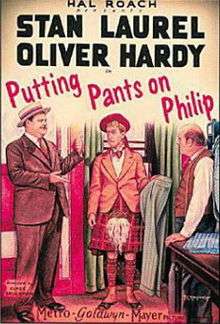Putting Pants on Philip
Putting Pants On Philip is a silent short film starring British/American comedy duo Laurel and Hardy. Made in 1927, it is their first "official" film together as a team.[1] The plot involves Laurel as Philip, a young Scot newly arrived in the United States, in full kilted splendor, suffering mishaps involving the kilt. His uncle, played by Hardy, is shown trying to put trousers on him.[2]
| Putting Pants on Philip | |
|---|---|
 Theatrical poster | |
| Directed by | Clyde Bruckman |
| Produced by | Hal Roach |
| Written by | H.M. Walker |
| Starring | |
| Cinematography | George Stevens |
| Edited by | Richard C. Currier |
| Distributed by | Metro-Goldwyn-Mayer |
Release date |
|
Running time | 19 minutes |
| Country | United States |
| Language | Silent film English intertitles |
The duo appeared in a total of 107 films between 1921 and 1950. The idea for the film was Stan Laurel's and was based on a story recounted by a friend while Laurel worked in music hall.[3] The archivist William K. Everson described the film as "one of the real gems of comedy from the late 1920s, and perhaps the most individual of all the Laurel and Hardy comedies, though not necessarily the funniest."[4]
Plot
Piedmont Mumblethunder (Hardy) is awaiting the arrival of his Scottish nephew Philip (Laurel) at a pier. Piedmont does not know what Philip looks like, but has a letter from his sister that says Philip is so shy around women that he breaks out in a rash at the mere sight of a female. Upon his first sight of Philip, Piedmont tells a bystander that he pities whomever has to collect this character—only to be upset when the man turns out to be Philip. Piedmont is embarrassed at the apparent effeminacy of the kilt-wearing Philip. The rumor of Philip being shy in the presence of women is completely inaccurate as Philip is an incorrigible skirt-chaser. At one point Philip loses his underwear and, pursuing a pretty girl, steps on a ventilator grate. This blows his kilt up which results in several women fainting.
Piedmont then takes Philip to a tailor to be fitted for trousers—an action that Philip resists greatly. Philip leaves the tailor to continue pursuing the young woman he saw earlier. Catching up to the woman, Philip takes off his kilt to cover a mud puddle. Rejecting this act of chivalry, the woman simply leaps over the puddle and leaves. Piedmont subsequently steps on the kilt and falls into a deep, mud-covered hole.[3] The film ends on a close up of Oliver Hardy's face showing "a soon to be classic look of chagrin"[5]
Production
Although this was their first "official" film as a team, the iconic Stan and Ollie characters and costumes had yet to become a permanent fixture. Their first appearance as the now familiar "Stan and Ollie" characters was in The Second Hundred Years, directed by Fred Guiol and supervised by Leo McCarey, who suggested that the performers be teamed permanently.
The film was partially shot at the historic Culver Hotel.[6]
Cast
- Stan Laurel - Philip
- Oliver Hardy - Piedmont J. Mumblethunder
- Charles A. Bachman - Officer
- Ed Brandenberg - Bus conductor
- Harvey Clark - Tailor
- Dorothy Coburn - Girl chased by Philip
- Sam Lufkin - Ship's doctor
References
- Gehring 1990, p. 62.
- Mitchell 2010, p. 229.
- Garza, Janiss. "Putting Pants on Philip (1927)". NYTimes.com. The New York Times. Retrieved 3 December 2015.
- Everson, William K. "The Theodore Huff Memorial Film Society". William K. Everson Archive. Retrieved 3 December 2015.
- Garza, Janiss. "Putting Pants on Phillip (1927)". AllMovie. Retrieved 18 March 2016.
- Smith, Leon (1988). Hollywood Goes on Location. Los Angeles: Pomegranate Press. p. 177. ISBN 0-938817-07-8.
Bibliography
- Everson, William K. The Complete Films of Laurel and Hardy. New York: Citadel, 2000, 1967. ISBN 0-8065-0146-4.
- Gehring, Wes D. Laurel & Hardy: A Bio-Bibliography. Burnham Bucks, UK: Greenwood Press, 1990. ISBN 978-0313251726
- Mitchell, Glenn. The Laurel & Hardy Encyclopedia. New York: Batsford, 2010; First edition 1995. ISBN 978-1-905287-71-0.